It seems like almost every cuisine out there has some sort of localized version of the dumpling.
The Japanese have the gyoza. The Chinese their wontons. The Italians embrace the ravioli and the tortellini. The Germans tout spaetzle, and the Nepalese their momos.
For the Mongolians, the dumpling – buuz being among them – is truly paramount to the cuisine, and the flavors and presentations of them very much support the notion.

Buuz, the Steppe and the “Monthly” Mongolian Cuisine
To understand buuz first requires a dive into the Mongolia’s cuisine and the country’s climate.
Why climate? The type of climate that constitutes much of modern-day Mongolia – the steppe – provides a lot of clues and insights into the overall culture and cuisine.
The steppe is a vast stretch of land ranging from Eastern Europe all the way into Eastern Asia and is characterized by its grassland qualities and temporal extremes. Because of low precipitation, the steppe climate does not support the growth of very many trees, but there is an abundance of grassland throughout, which translated to an abundant food supply for grazing animals like cattle, goats and sheep.
The steppe can also be synonymous with massive extremes in temperature. During the summertimes, you might have a 90 degree (Fahrenheit) day, whereas a day in winter might go as low as -50 degrees!
Because of these different weather extremes, Mongolian cuisine are split into two different time frames: the “red months,” and the “white months.” The harsh winters of the steppe are considered the “red months,” where many of the Mongolian dishes eaten will be highly caloric and fairly meat heavy. Conversely, the summertime “white months” and corresponding fewer caloric needs implies a greater focus around dairy products and less meat.
Needless to say, the Mongolian diet centered around animal and dairy products is one not very accommodating to the vegetarian or vegan lifestyle.
You May Also Like….
If you like dumplings, you might want to check out our other recipe for Tibetan Steamed Dumplings (Momos) with sauce, or Slovakian Potato Dumplings, or Siberian Meat Dumpling (Pelmeni)
About Buuz
Interestingly, buuz (pronounced like “boze” or “bohtz”) is one of the few dishes that is eaten year-round and can, in some cases, be enough as a standalone meal. Most notably, though, buuz is very commonly eaten around the time of Tsagaan Sar, the Mongolian Lunar New Year, as part of a greater feast.
Buuz bears a strong resemblance to both the Nepalese momo and the baozi that is present in several different Chinese cuisines. Much like these types of dumplings, buuz is cooked through steaming, although there are also the Mongolian water-boiled bansh and the deep-fried khuushuur that are relatives to buuz.

About the Recipe
When it comes to ingredients, the inputs into buuz are actually relatively simple. At the heart of any buuz is the meat filling, which is most likely a ground mutton or in some cases (like ours) ground beef. Around the filling is a simple dough made of water and wheat flour.
Depending on the recipe, there might be additional ingredients like cabbage, rice, potato and perhaps some spices, but these are more to the individual recipes than real staples of the recipe. It’s helpful to note that Mongolian cuisine in general does not have a tremendous amount of vegetable or spice influences in it.

The true art to making buuz, however, comes in the folding of the dough around the meat. Admittedly, as you’ll see in the photos, we had a bit of difficulty on perhaps the most important part of buuz and are anything but masters of folding and creating the dumpling.
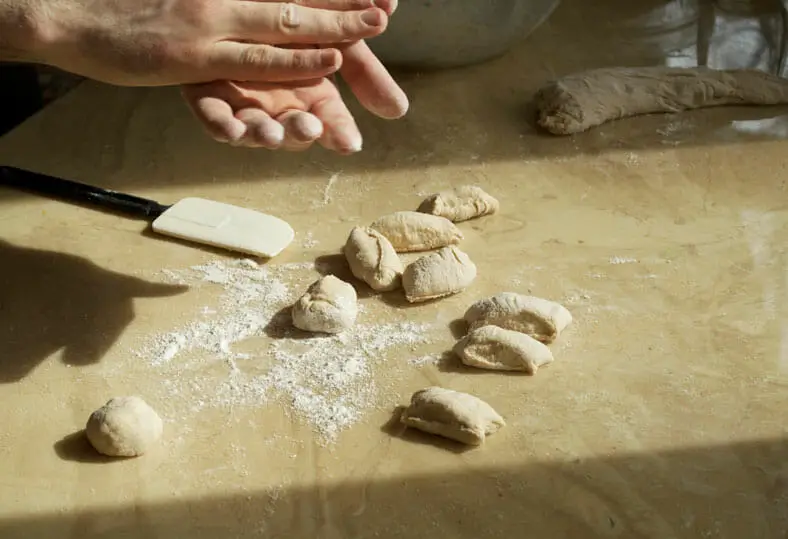
Folding the Buuz
There are three particularly traditional ways in which to fold your buuz.
First, there’s the rounded way, which perhaps is most recognizable and most popular. To make a rounded buuz, you pinch small series of folds and converge them in the center around the dumpling. You can either fully cover your dumpling, or you can leave an open hole in the center, although having a slightly open hole is helpful to ensure that the steaming process fully cooks the inside filling of the dumpling.
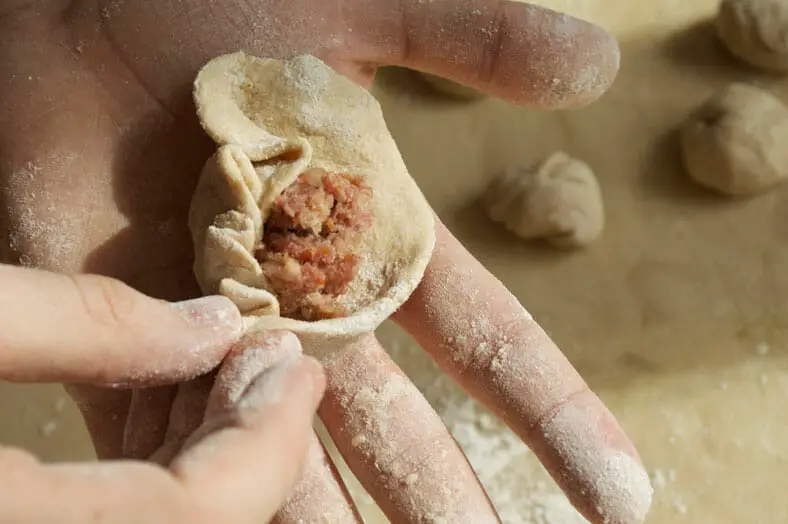
Next, there’s the folded technique, which is so much easier than the rest. With the folded technique, you cover the entire filling with the dough and pinch into the corners. You’ll need to ensure there’s some openings available, but this is a very easy way to prepare it.

Finally, there’s the semicircular way of preparing the buuz. This is perhaps the least traditional way of doing them and more reminiscent of other types of dumplings from other cuisines, but in any case it can be done. To fold in a semicircle, you fold half the dough over the filling and converging with the edges of the other half, and then you’ll pinch along the spine of the dough to close up the dumpling.

Regardless of how you fold, a key component to making buuz comes in the steaming cooking method. Once you’ve well oiled your steamer or any special perforated pans or inlays, you set the buuz in and cover, bring the water underneath to a boil, and let them steam for roughly 10-15 minutes as you see fit.
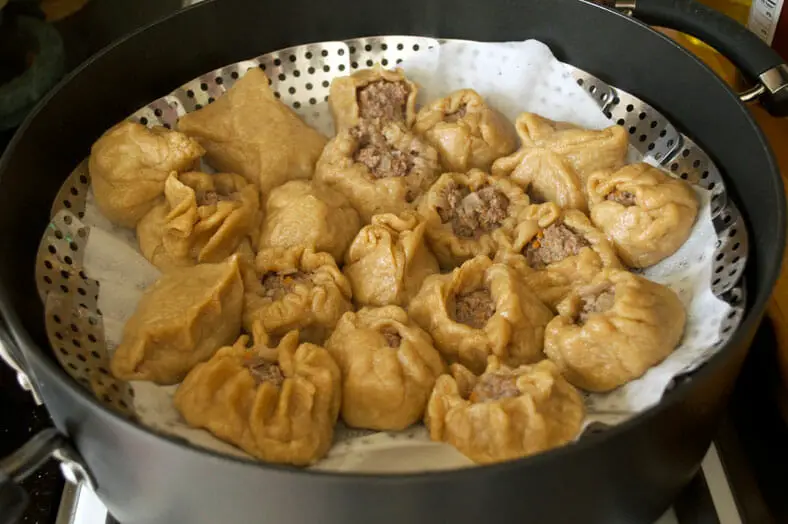
Our Take on the Recipe
Now might be as good at ever to readily admit that, even after many attempts, our dumplings were far from perfect. Even with the help of the tutorial from our original reference recipe, we only lucked out a few times in making our buuz look like the professionals.
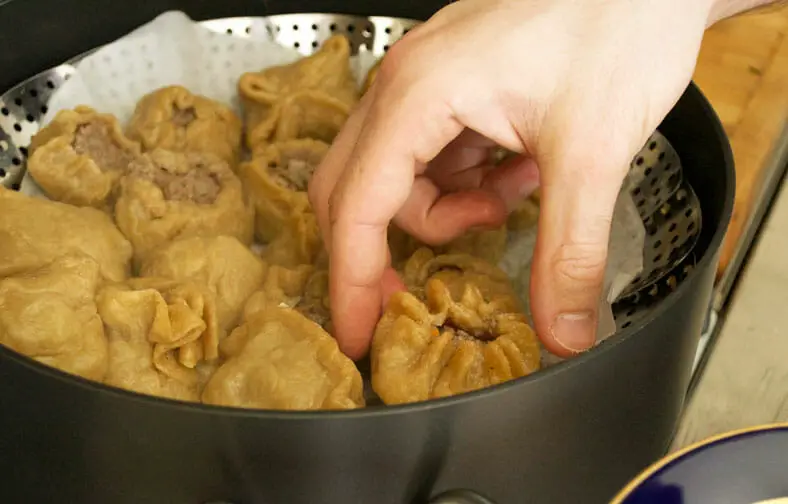
When it came to the ingredients, we did make some slight additions based on other recipes we found. For one, we added another spice to the mix. Granted, Mongolian food isn’t known for being spice-intensive, but we came across several recipes that included ground coriander. For our recipe, we pre-made a spice mixture of freshly ground caraway and coriander seeds along with salt and pepper.
Also, we added another few vegetables into our buuz filling. Across different recipes, the three most common vegetable additions were onions, carrots, and cabbage, so we opted to scale down the proportions of each and include bits of all three. This is totally optional, though, but we would suggest adding at least one of the vegetables into the filling.
Finally, with regards to our flour, we stayed away as we usually would from the refined and bleached all purpose flour. Instead, we opted for an organic whole wheat flour with all its bran, endosperm and germ-y goodness. It made for an interesting albeit subtle change in the dumpling wrapper, but it turned out to be a pretty good substitution.
Other than that, the recipe is very simple to make. As for the folding, we’ll have to get back to you on that…
Enjoy!
How do you fold your buuz? Comment below!


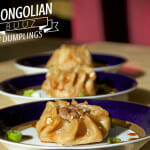
Buuz
- Total Time: 1 hour 30 minutes
- Yield: 15 dumplings 1x
Description
Buuz in organic whole wheat flour.
Ingredients
Dough
- 2½ cups organic whole wheat flour
- 1 cup lukewarm water
- 1 teaspoon salt
Filling
- ½ pound ground beef or sheep, preferably with higher fat content around 80/20 if not more
- ¼ cup water
- ¼ head of cabbage, finely chopped (~1/4 cup)
- 1 medium sized carrot, grated (~1/4 cup)
- ½ medium-sized onion, finely chopped (~1/4 cup)
- 2 cloves garlic, minced
- 1 teaspoon salt
- 1 teaspoon ground black pepper
- 1 teaspoon caraway seeds
- 1 teaspoon coriander seeds
Instructions
Stage 1 – Pre-make Dumpling Dough
- Mix your wheat flour, water and salt together in a bowl. Roll and knead the ingredients together as it forms a dough, then cover and refrigerate for 1 hour. By the time you take it out of the fridge, the dough should be fairly firm and not wet.
Stage 2 – Preparing the Filling
- Put the black pepper, salt, caraway seeds and coriander seeds into a spice grinder and blend to a spice mixture powder
- Then, in another bowl, combine your ground meat, cabbage, carrots, onion, garlic and spice mixture. Be sure to mix the ingredients together well (perhaps even with your hands) to evenly distribute the ingredients around.
Stage 3 – Pre-Folding
- Take your dough out of the fridge and lay onto a pre-floured work surface
- Roll your dough out into a long rope, then cut the dough into 1-inch pieces. Each of these 1 inch pieces will be used to make 1 buuz
- Use a rolling pin to flatten your 1 inch piece and to make it more foldable. Roll around in a circle to keep the dough’s circular shape
- With the flattened dough in your hand, take approximately ¾ to 1 tablespoon of filling and place in the center of the dough
Stage 4 – Folding the Buuz
- If folding the traditional round way: Pinch two parts of the dough together and bring to the center. Proceed around the wrapper folding the next piece of dough into the folded piece. You should get something similar to a star shape once you’ve made your entire way around
- If folding the closed folded way: Take two sides of the wrapper and converge them on the center above the filling. Repeat with the other two edges until all four edges are met in the center. Pinch together the dough to encase the filling inside the wrapper
- If folding the semicircular way: Take one side of the wrapper and fold it over the filling and to the other edge of the wrapper. Pinch along the entire convergence of the doughs to get a semicircle or moon-shaped dumpling
Stage 5 – Steaming
- First, take your steamer or a large stockpot and fill with 1-2 inches of water on the bottom
- Next, either oil your steamer grates or put a piece of wax paper (with holes poked through) on your stockpot inlay to prevent the buuz from sticking
- Place your folded buuz into the steamer and cover
- Bring the stockpot or steamer to high heat and the water to a boil, then leave covered for 10-15 minutes as the buuz steams together
- Remove after steaming and serve!
Notes
For reference on how to fold buuz properly, please refer to our original reference recipe from MongolFood.info
- Prep Time: 1 hour, 10 mins
- Cook Time: 20 mins
- Category: Entrees
- Cuisine: Mongolian


wWat a great lesson in an ethnic cuisine I know nothing about! I’m particularly interested because dumplings of all types are so delicious – learning one more country’s way of making them would be awesome.
We’re totally with you on that, Laura! All dumplings are awesome, and we’ll definitely be looking into other types from other cuisines down the road too 🙂